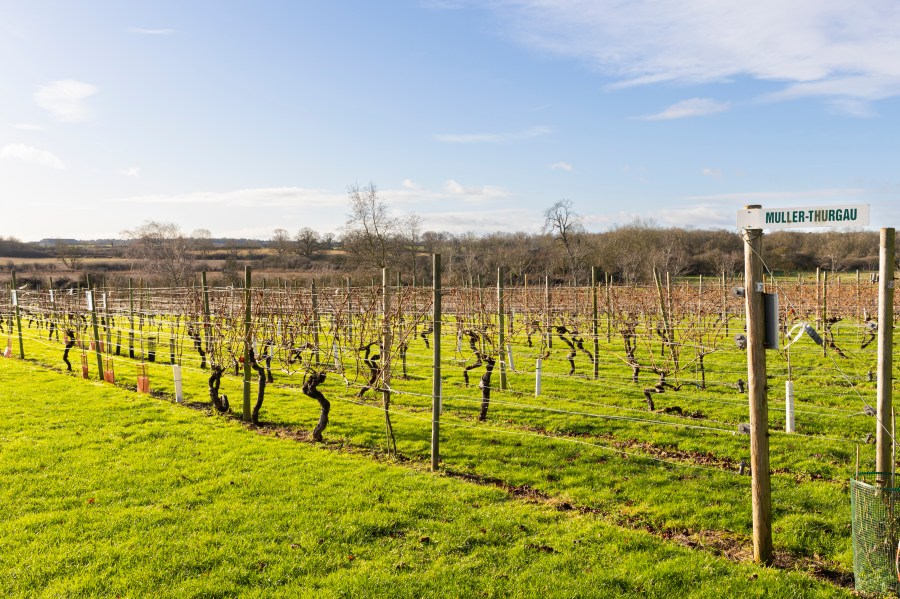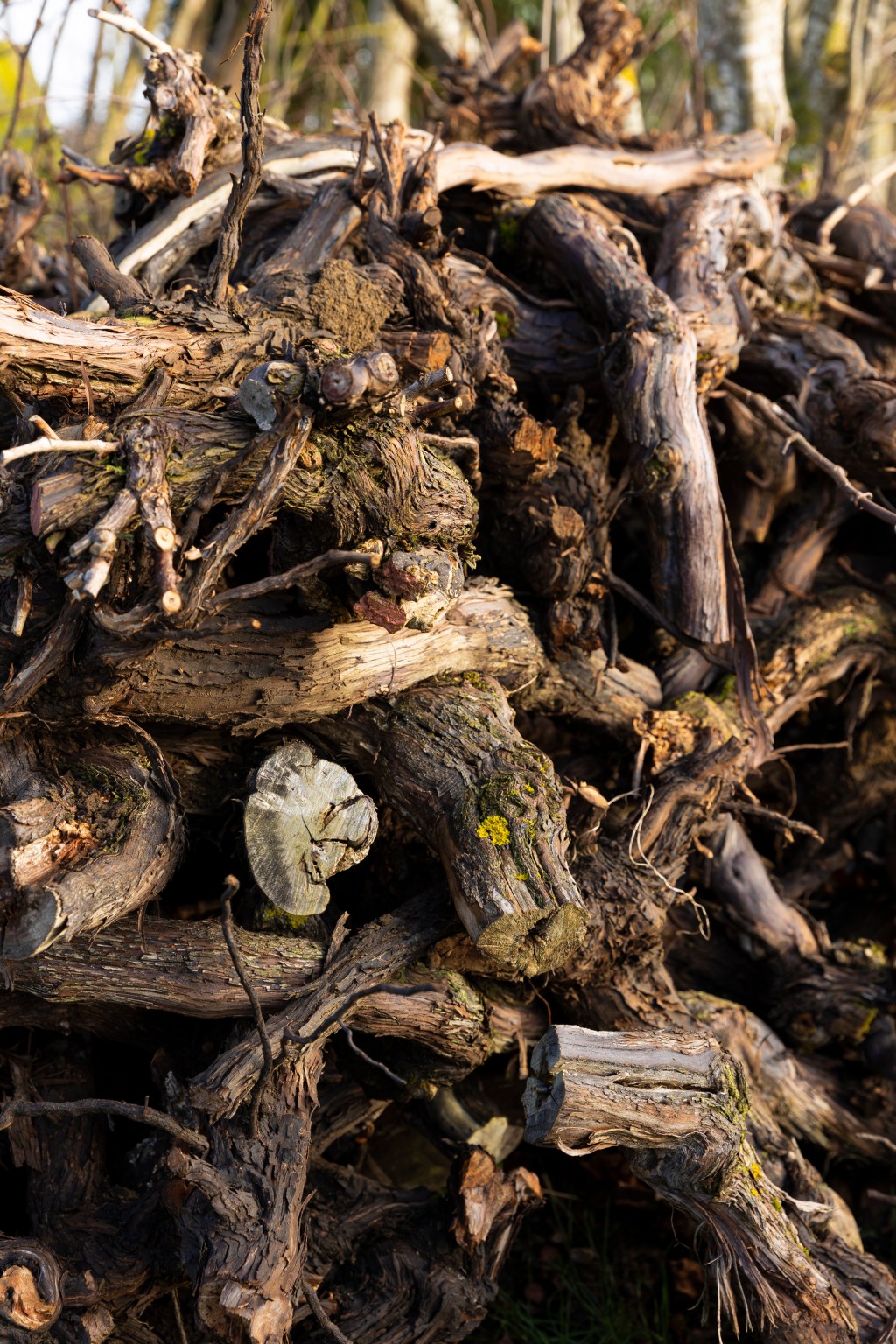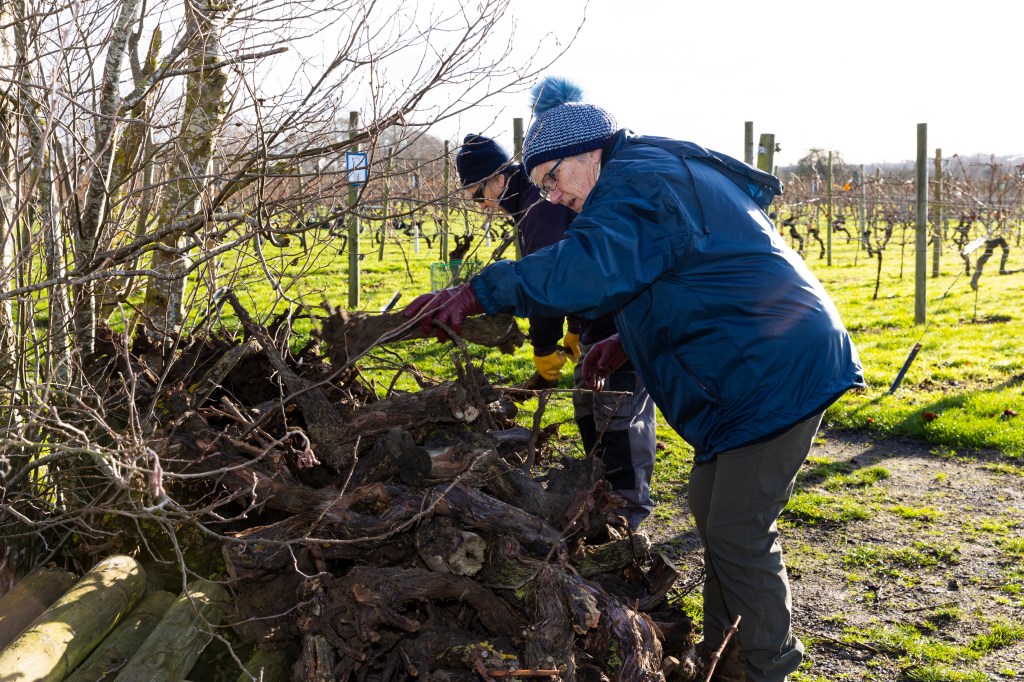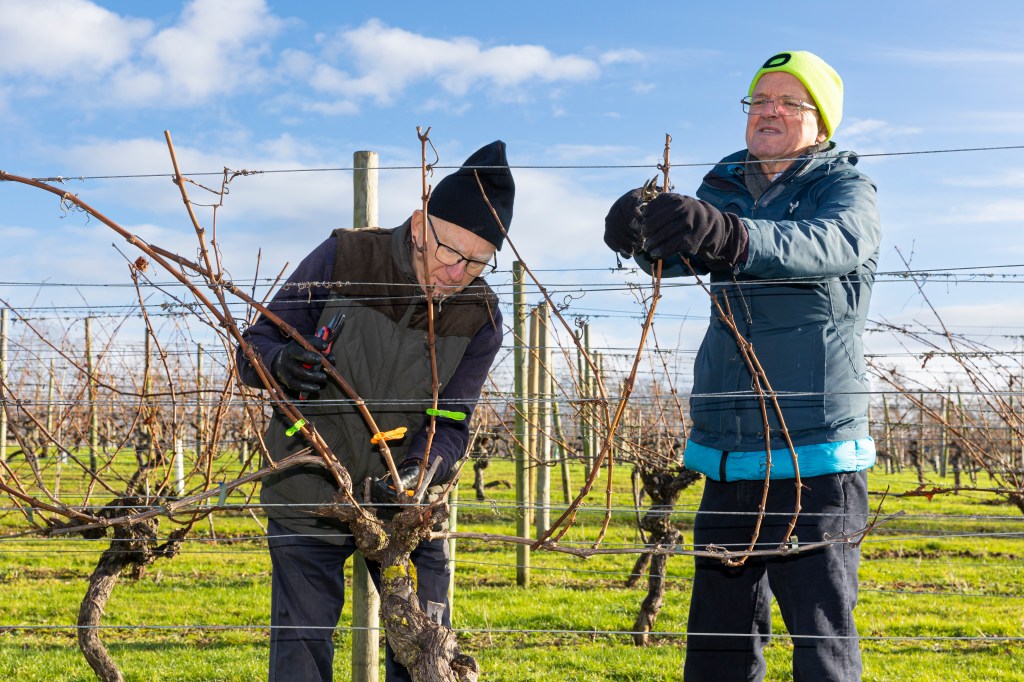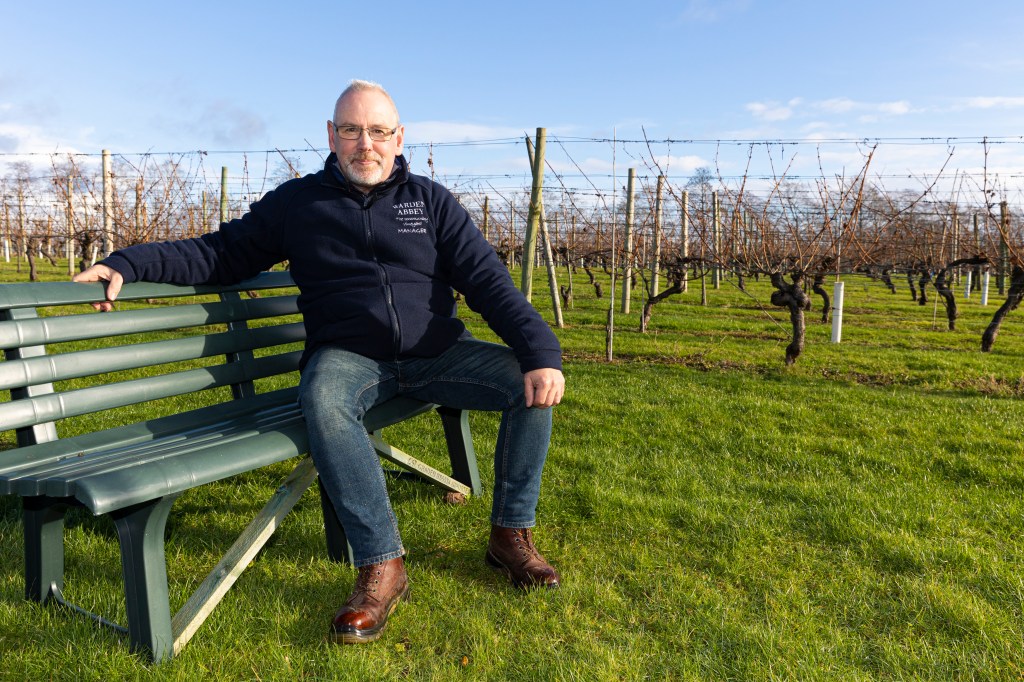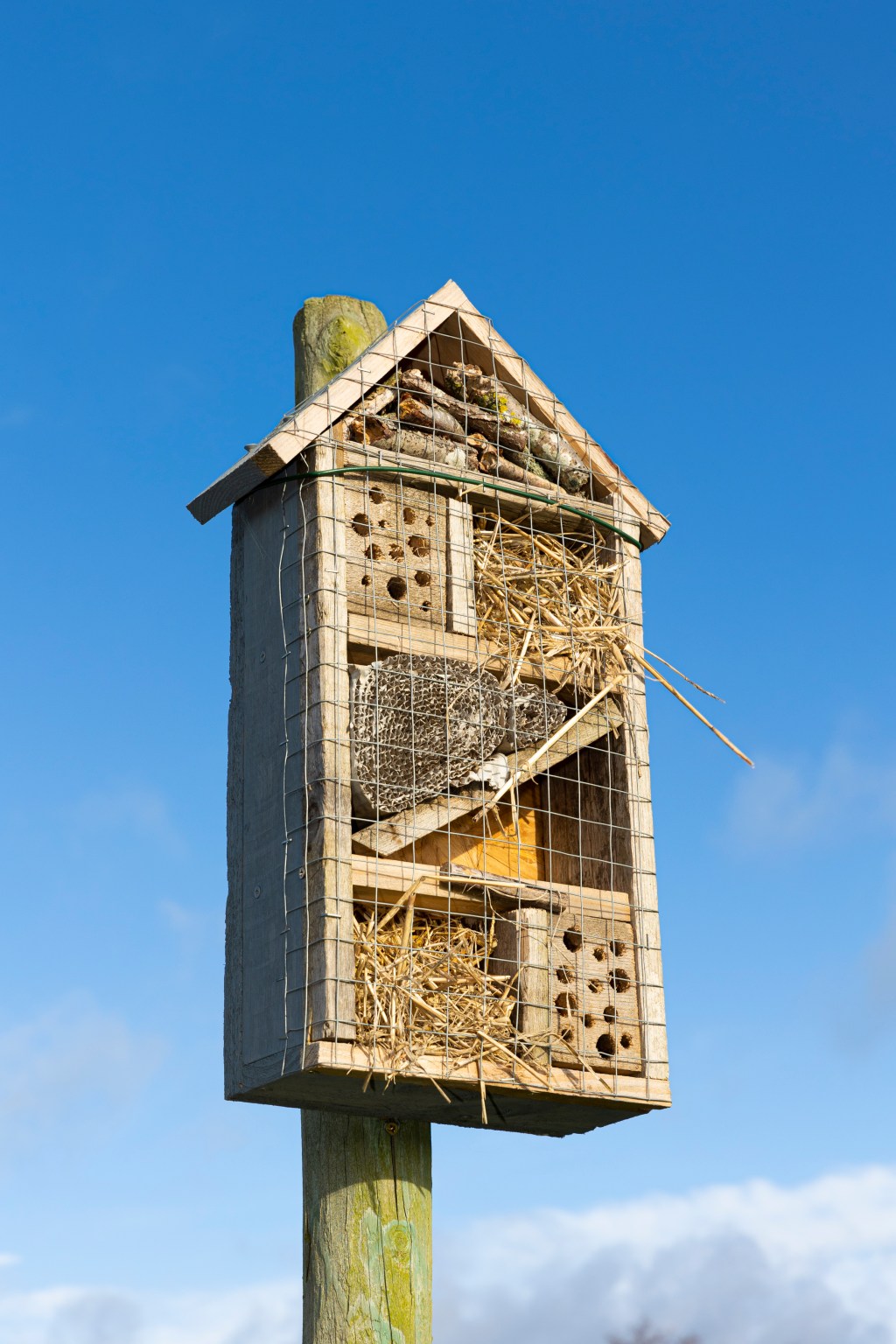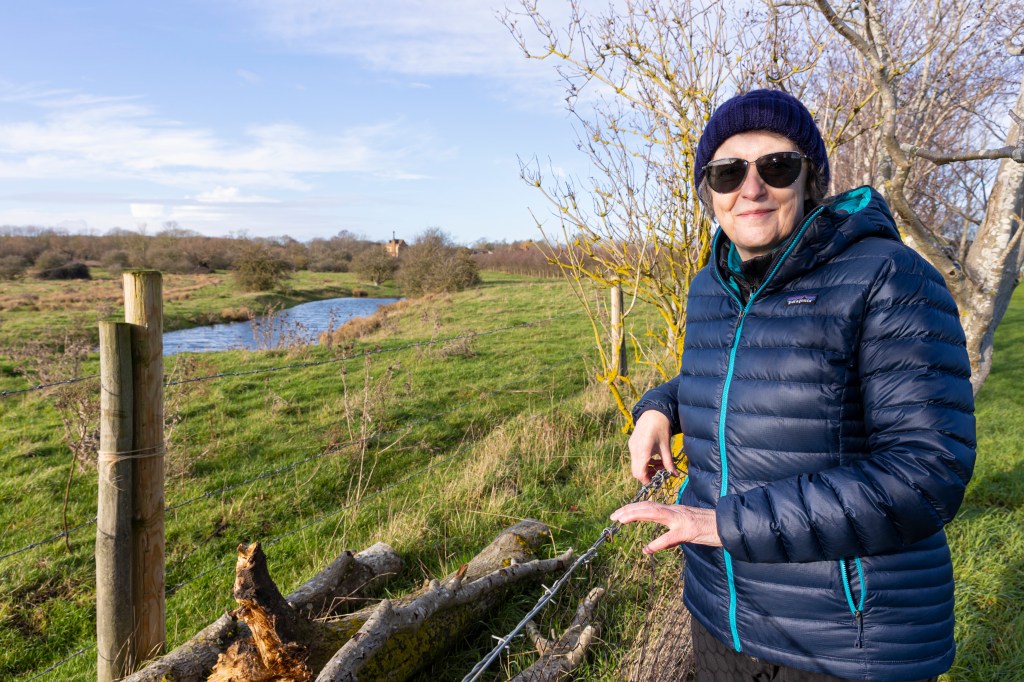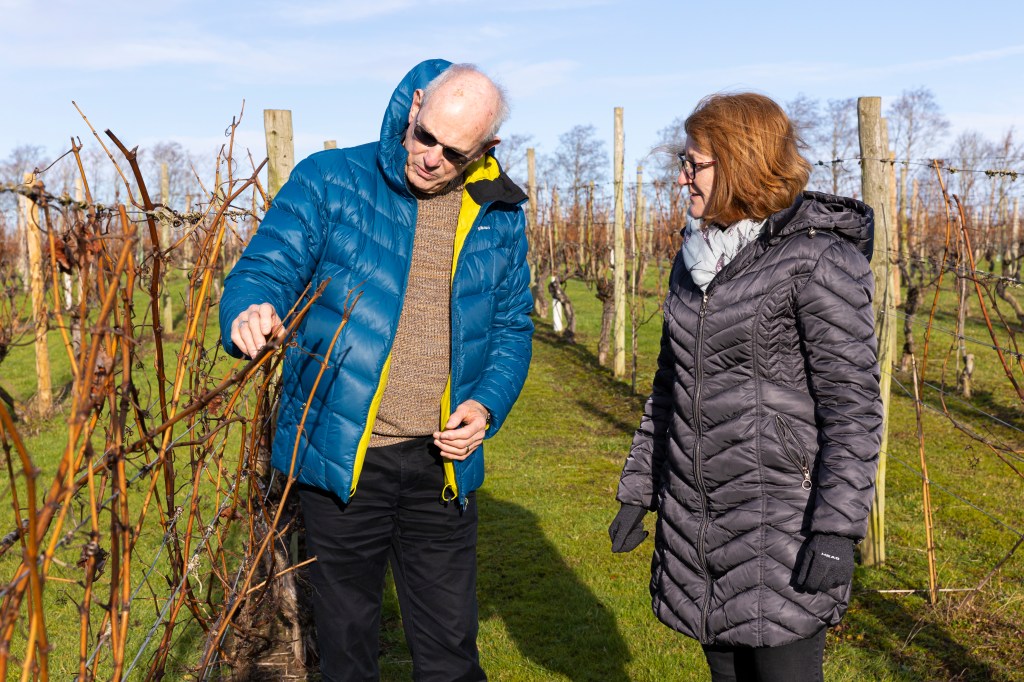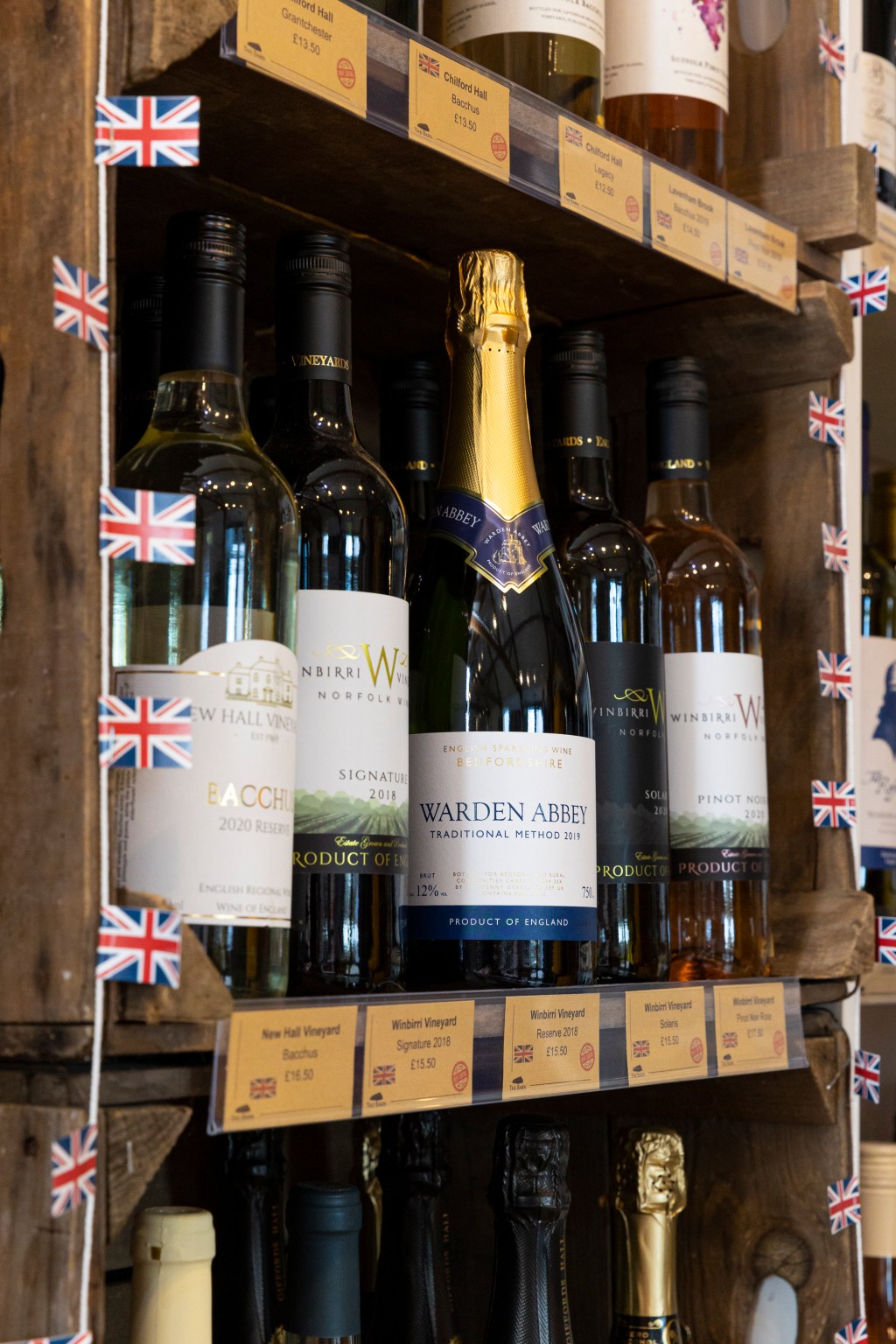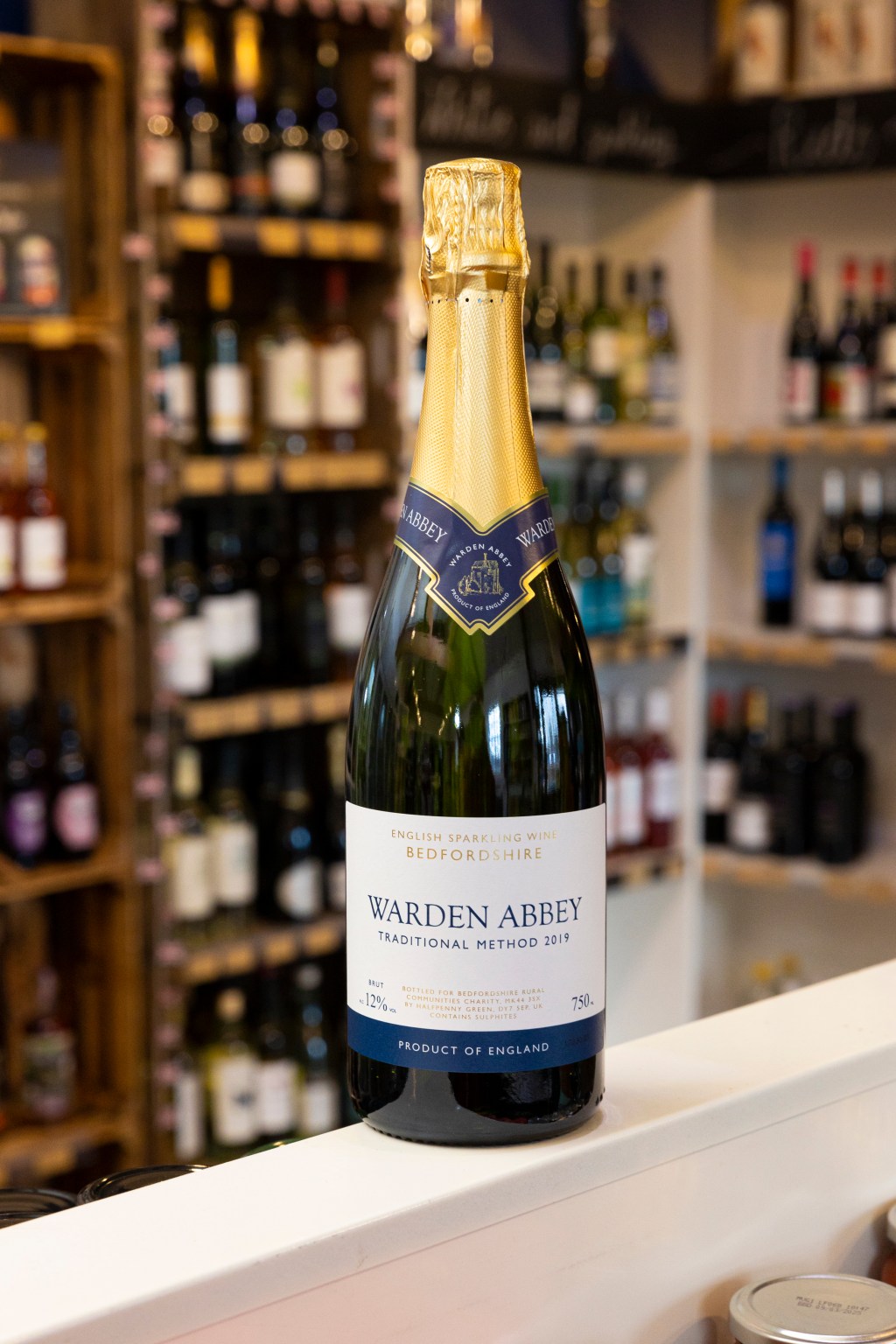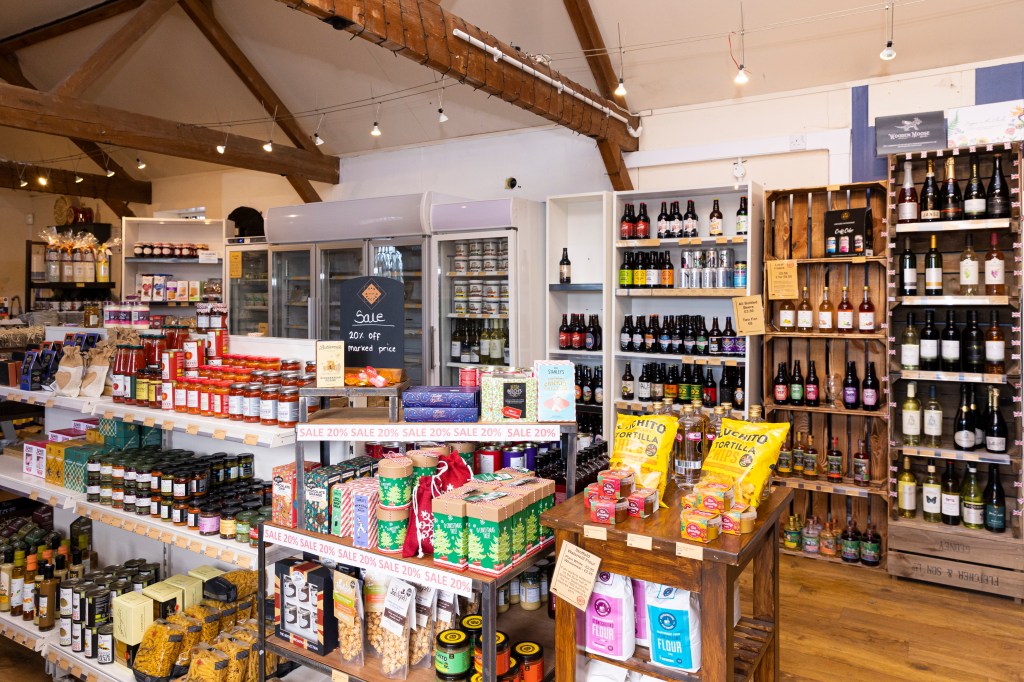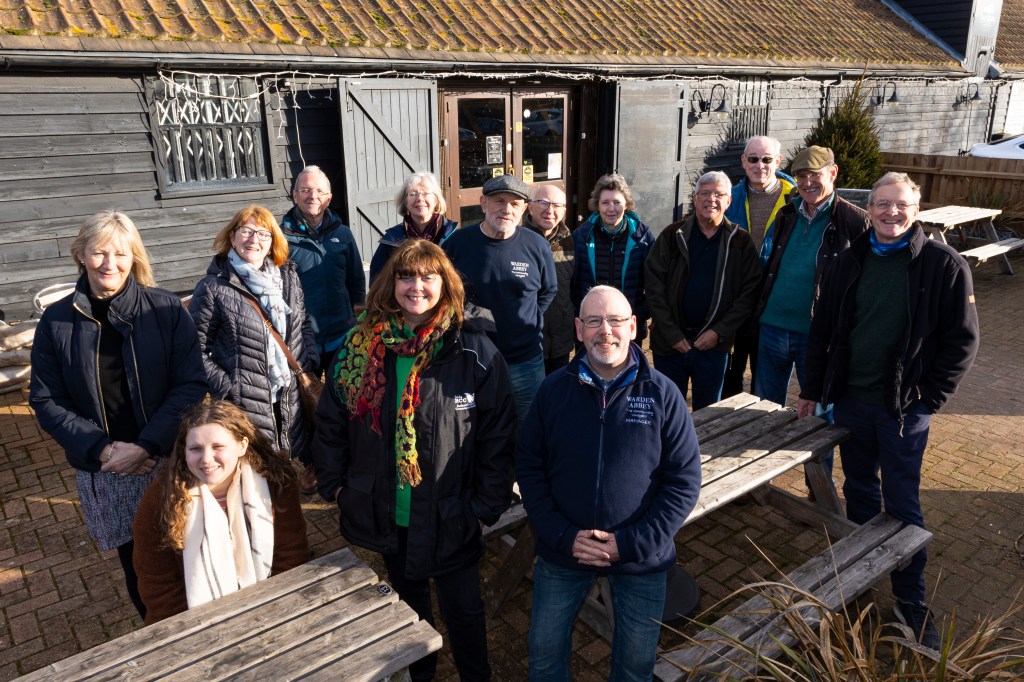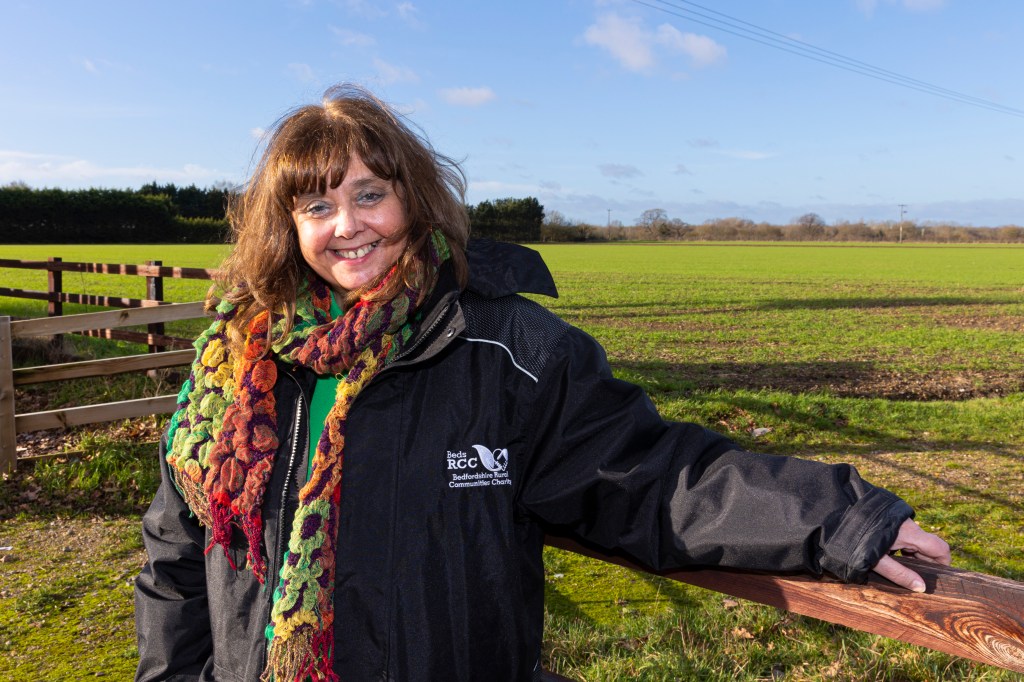This month Vineyard visits the remarkable Warden Abbey Vineyard in Bedfordshire located on the site of a medieval abbey.
When you arrive at any vineyard in the UK or anywhere in the world for that matter there are certain things that will be the same. There will be soil, there will be posts and trellis and there will of course be vines. These points will differ in the detail but they are key elements of any vineyard however there are so many unique points at Warden Abbey Vineyard, it is difficult to know where to begin.
Perhaps it might be best to start with Henry VIII. According to Margaret Roberts, a member of the Friends of Warden Abbey who is also the historian for the site “it was on 4 December 1537 that the Dissolution of the Monasteries” arrived in this small part of Bedfordshire and the occupation of this site that had begun in 1135 ceased. The Abbey was of the Cistercian Order and in her booklet titled “Warden Abbey the Monastic Landscape,” Margaret writes: “Warden was one of six Cistercian abbeys in Britain known to have had a vineyard, with about 37 acres under vine it was by far the largest.” It is fascinating to learn that the current area where the vines are planted had been used in late middle ages for industrial purposes. In the soil lay hidden many fragments of tiles, some with colours that are extremely well preserved. Even an old stone masons chisel or wedge has been unearthed. The vineyard occasionally reveals one of these remnants of the past as the vines are tended and cared for. Whilst we are standing in the vineyard Margaret points out an area of 3.5 acres adjacent to the current vineyard which until recently had a disputed heritage. Margaret explained that she has recently been able to prove that this area was part of the medieval monastic vineyard.
The site is now part of the Whitbred Estate. In 1985 Lady Whitbred established a vineyard on part of the same site that had been home to vines around eight centuries before. The symmetry of this is quite breath-taking and the site is now run for charitable purposes by Bedfordshire Rural Communities Charity (BRCC) in association with the Friends of Warden Abbey.
The Friends of Warden Abbey are all volunteers who generously give of their time and energy to ensure that this 4.5 acre plot with 4,500 vines continues to be cared for. Gerry Nolan, Chairman of the Friends explained: “Every Tuesday and Friday there is an open invitation for any of the 70 volunteers to come and work in the vineyard. The volunteers undertake all the jobs in the vineyard from planting through to pruning and on to harvest. “New volunteers are paired with experienced workers,” said Amanda Gibson a member of the committee. “There is no pressure and no rota; people do what they feel they are capable of and we all work together,” she added. “Even if you turn up once in a blue moon we are still delighted to see you,” said Amanda. A real sense of unity and working together is evident and it becomes clear throughout the visit that excellent award winning wine is not the only product of the vineyard. “I have made so many friends,” said Amanda and indeed our conversation is joined by more and more people. Apart from the social aspect of the vineyard Gerry points to the peace and tranquillity that can be found here – wellbeing walks regularly take place in the vineyard. Our visit took place on a cold but beautiful winter day and it is easy to see why the group have had new volunteers since the challenges of Covid-19 and its associated difficulties. Volunteering here would be such a rewarding experience.
The cold day prompts a conversation about the frost protection measures the vineyard puts in place. “We don’t, we simply can’t afford it,” said Gerry. “We do leave the tying down until later than other vineyards as a way of protection for the buds, but that is the best we can do,” Amanda added. This lack of frost mitigation has led to some very large fluctuations in harvest figures. The worst year was 2020 which saw significant frosts affect the vineyard and only one tonne was harvested that year. The average number of bottles that are produced is around 3,000 but in the very best year 6,000 bottles were produced.
To include the local community, each year the vineyard holds an open day attracting 900 visitors. This year it takes place this year on
10 September. There is a small charge at the gate and the vineyard hosts between 25-30 stalls. Wine tasting classes and events related to the history of the site together with sales of wine on the day are extremely valuable to the group. It is clear however that this open day is about the local community as much as it is about the vineyard, with attractions during the day bringing the history of the site to life for both children and adults. Old trunk prunings are sold off as garden sculpture or as nature hotels so it is even possible to literally take a piece of the vineyard home.
The open day is one of many events throughout the year that encouraged visitors to Warden Abbey. The vineyard tours provided have the option of being either guided or self guided. The self guided vineyard tour utilises QR codes that are scanned on a mobile phone and then take the user to the tour information for that part of the vineyard. There are also summer picnics on Sundays and Teddy Bear picnics are a nice touch that ensure the whole community is included. There is even an opportunity for members of the public to buy a pruning experience at the vineyard. The Friends of Warden Abbey all bring valuable ideas and skills to the vineyard and this gives a depth and diversity that are both surprising and unique for this small site.
Celebrating their 70th Anniversary in 2023, Bedfordshire Rural Communities Charity (BRCC) was originally set up as part of a network of Rural Councils of which there are 39 across England. Along with the vineyard the charity also has a farm shop which sells the Warden Abbey wines and heritage centre tea room. Tracy Cowan, Chief Executive of BRCC said: “The vineyard is our biggest community project.” The charity works hard for the Bedfordshire community providing many services including transport for members of the community that have mobility issues or helping local residents complete paperwork. “During Covid-19 many of our drivers took people to vaccine appointments and delivered food parcels. The community and wellbeing team made hundreds of wellbeing calls,” said Tracy who also praised the team for all the hard work they do. There are many initiatives that are undertaken by the charity such as village hall support, community engagement and others relating to Green Infrastructure – there is even an inhouse ecologist. One aspect of the charity’s work is helping mental and physical wellbeing by connecting with green spaces. The vineyard dovetails with these objectives not just for the volunteers but also by hosting activities for the community. Tracy spoke of plans to set up ‘Yoga in the Vineyard’ classes which would make for some interesting photographs.
Following along with the local community theme at Warden Abbey, the vineyard already hosts groups of young people. Rafe Radford, one of the volunteers and a retired GP explained that under 18s who have learning difficulties come to the vineyard and get involved in activities such as creating bug hotels “they have mixed abilities but they all enjoy returning to the vineyard” he said. The vineyard also works with semi independent adults that have learning difficulties and these groups take part in tasks such as planting new vines.
Tim Taylor, the newly appointed vineyard manager is quick to point out that they have to be creative in the vineyard. In the words of the philosopher Plato: “Necessity is the mother of invention” and this is evident at Warden Abbey. The vineyard is nearly forty years old and as such there are places in the rows where a vine might have died so to fill in the gaps a layering technique is used. This old technique basically takes advantage of the vines reproduction process. “A cane is buried and this cane will develop its own root system and once this is established we cut what we call the umbilical cord,” explained Amanda. While the vineyard is frugal there are also plans for the future. New vines are planted but only in blocks of 200 at a time. Providing the young vines with enough water is a challenge for the group of volunteers so planting is undertaken with great forethought. There is a plot of vines that are different to the three established varieties; they include Divico, Regent, Orion and Seyval Blanc. Tim explained: “Before we plant any new vines we need to be sure that the varieties are suited to this vineyard.” The soil is a mixture of Hanslope and Evesham clay and “can vary from the one end of the row to the other,” explained Gerry.
Tim has a background in farming and estate management and after a varied career path moved into viticulture and studied at Plumpton. He stated: “Viticulture has the ability to turn an average piece of ground into something amazing.” Earlier in his career he helped to establish a vineyard from scratch planting acres of new vines, however at Warden Abbey Tim is excited by the prospect of “making the best wine from the old vines focussing on quality and the point of difference this can create.” The vineyard is mostly Reichensteiner, Muller Thurgau and Bacchus which Tim described as: “Three old school varieties; great classics.” Tim wants to focus on the idea of regenerative farming and the nutrition of the vineyard accepting that whilst the old vines might not produce high yields they do produce high quality and intense flavour profiles. “At Warden Abbey we are custodians of the present and the past,” he concluded.
Moving into the future there are so many possibilities for Warden Abbey Vineyard, including that of adding a pod to house events. Difficulties at the vineyard become obvious when I am told that to put up a permanent structure will not only require funding but due to the designation of a heritage site there can be no conventional foundations dug meaning a special base will need to be constructed to comply. There is also the possibility of extending the vineyard and Tim is keen to explore the idea of working with other vineyards, such as volunteering to help with tasks in the vineyard in exchange for goods or services. The not for profit community vineyard benefits from local companies that as part of their Corporate Social Responsibility programmes donate labour days and there are many opportunities for other companies to become engaged with this beneficial project. Securing funding streams has not always been an easy path though. One such example was a collaboration with an agricultural college which used the vineyard for one of their courses but this course was cut from the curriculum in 2013 and this funding was lost.
Warden Abbey Vineyard has achieved so much and the wines that are at its heart have also won awards. Gerry explained part of the reason for this: “Each bunch of grapes is picked by hand and carefully looked at before it goes into the crate.” The attachment to the vineyard of all those who volunteer is evident and brings to mind the “handmade with love” ethos. “Everybody that comes here is invested in the vineyard because they get so much more out of it than a glass of wine,” said Amanda. “The wine is almost a by product of all the other benefits of the vineyard,” said Gerry smiling. Although the wines are made in relatively small quantities the 2015 Bacchus was awarded a Bronze Medal at the Decanter Wine awards. The Bacchus is only made in exceptional years and there is now a Bacchus 2019 available. Indeed 2019 was a great year for the vineyard and there is also a Warden Abbey Brut 2019 made in the traditional method and disgorged in 2022. The production of 1,500 bottles is made from three grapes consisting of 43% Muller Thurgau, 39% Reichensteiner with the remaining 18% Bacchus. From 2018 there is also a still white wine The Reformer which is 80% Reichensteiner 20% Bacchus. The wines are available from the cellar door but there are various stockists in the county including The Kingfisher hotel and pub which carries the still wines. This again is a lovely example of communities working together to promote local produce and also fits with the food ethos of The Kingfisher which uses beef produced only a few miles down the road. The 2018 wines were made by the team at Halfpenny Green and after the disruption of Covid-19 the wines will again be made at this family run Staffordshire Winery which is ideally suited to the small production of the Warden Abbey Vineyard.
As I drive away from the vineyard up the single farm track I am slightly overwhelmed by what is being achieved here in this place where nearly 1,000 years of history are literally beneath your feet. The vineyard may not be profit making, but the community profit profoundly from these 4.5 acres tucked away in rural Bedfordshire.
- Tim Taylor, vineyard manager
- Margaret Roberts
- Gerry Nolan and Amanda Gibson
- The team outside the farmshop
- Tracy Cowan

